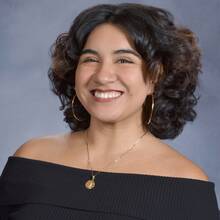I was raised in a primarily Spanish-speaking household and have always been taught the importance of language inclusion. Reflecting on Pope Francis’ legacy this week, I am especially grateful for the example he set as the first pope who was a native Spanish speaker and a Latin American.
My younger brother and I were raised speaking Spanish. The nicknames and the jokes and the regañadas (scoldings) were all told and retold in our parent’s native language. It was not until characters from shows like “Dora the Explorer” and “Elmo’s World” filled our television screens that we began to learn English. And even then, the Mexican soap operas and news stations received more air time in our home.
Once we started school, our understanding of English quickly expanded. And yet our home remained an Aquí se habla español (“Here you speak Spanish”) environment. I lost track of the amount of times my brother and I began to speak in English at the dinner table only to be promptly scolded for speaking in a language our grandmother and other family members did not speak. We were taught that it was impolite—but more importantly, exclusionary—to converse and laugh in a language others did not understand.
So you can imagine the fervor that erupted in our home when Papa Francisco was elected to the papacy on March 13, 2013. As a devout Catholic family, el papa was a very big deal. I was only 10 years old at the time, but I already understood why this meant so much to us.
The language of our faith was Spanish. My godmother sat me down and taught me the Nicene Creed in Spanish as a part of my first Communion preparation. We attended the Spanish-language Mass on Saturday nights at our local parish. And we were immensely fond of the church’s pastor, a Spanish-speaking priest of Italian heritage (like to Pope Francis), who would give the most beautiful homilies. We were not alone in our desire for community and cultural understanding through a shared language, as the rapidly growing Spanish-language ministries at our parish reflected. Still, we often felt isolated in the context of the larger, English-speaking parish community.
But then came the new pope, born in Argentina, speaking Spanish in his official addresses. We were ecstatic. There are, of course, oral translators and written translations so the pope’s message can reach the 1.4 billion Catholics around the world, who speak many languages. But there was something special about my family being able to listen to Pope Francis address the church in his native language, and ours.
I understood the profundity of this feeling of inclusion when I had the privilege of attending a papal general audience in Rome. After we had sat waiting for nearly two hours in the blinding summer sun, Pope Francis arrived at St. Peter’s Square and delivered his address. He began speaking in Italian, but then repeated his message in Spanish. Even though I had heard Pope Francis speak Spanish before, I was stunned when I realized I recognized his words. Listening to him speak, live and in person, with the nuance of someone fluent and comfortable in a language, was remarkable.
There is a moment that now lives prominently in the Catholic imagination when the pope’s Spanish is on full display. During his address to the young people attending World Youth Day in Lisbon on Aug. 3, 2023, he proclaimed that, in our church, there is space for everyone, and that Jesus calls us just as we are:
Jesus lo dice claramente. Cuando manda a los apóstoles, ha llamar para el banquete de ese señor que lo había preparado, dice “Vayan y traigan a todos.” Jóvenes y viejos, sanos y enfermos, justos y pecadores. Todos, todos, todos.
[Jesus says this very clearly. When he sends the apostles to gather people for the banquet prepared by the man, he says “Go and bring everyone.” Young and old, healthy and sick, the just and sinners. Everyone, everyone, everyone.]
Todos, todos, todos. Everyone, everyone, everyone. Speaking to Catholic youth, the Catholic Church of tomorrow, he takes the time to emphasize how necessary it is to welcome everyone into our Catholic family––regardless of our differences. Todos means “everyone” in both Spanish and Portuguese, a call for all to follow Francis in this promising direction. I pray that our next pope will also strive to represent the diverse people who make up the church, particularly those with immigrant roots.
As we continue to mourn the loss of Pope Francis, I am overwhelmed with gratitude for the pope of the margins, who like many other Catholics in the world, was committed to inclusion in the church. Que en paz descanse papa Francisco.






